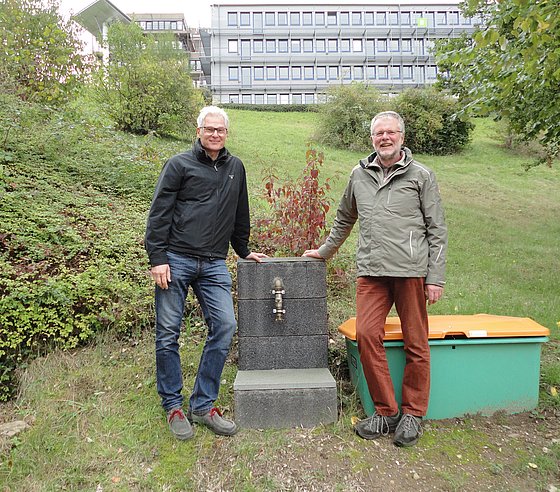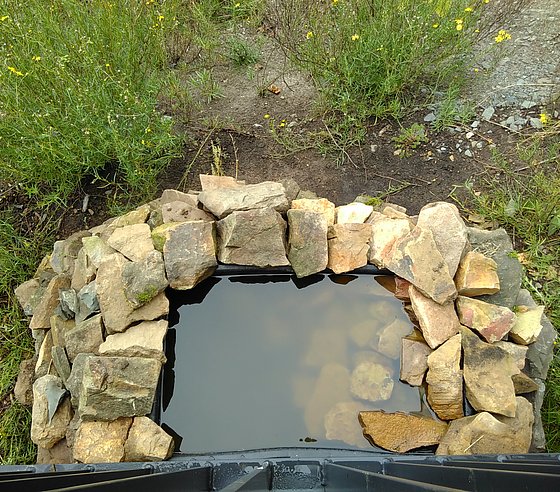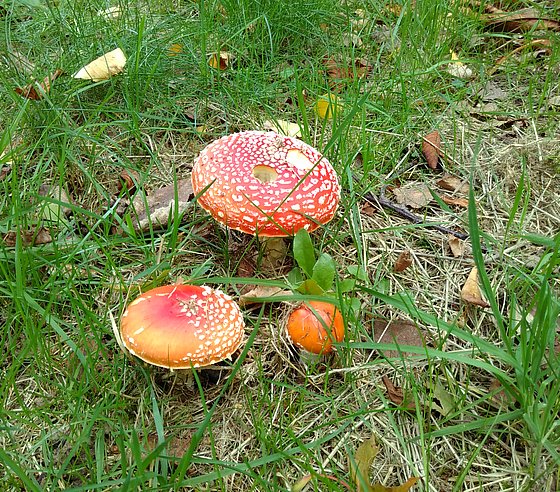
Dr Kischkel (vice-president for administration and finance at the University of Wuppertal) and Mr Wissemann (Dec. 5) Photo: Gertrud Lohaus

Small rainwater basin for insects, birds and other animals Photo: Gertrud Lohaus

Moisture-loving fungi (fruiting body of the fly agaric) Photo: Gertrud Lohaus
Rain - Water - Plants
Wuppertal still receives more rainfall than many other areas of Germany. By mid-October 2022, it had received 800 mm of precipitation, compared to 500 mm in Cologne and 300 mm in Berlin. Apart from the lower quantities compared to previous years, the distribution of rainfall has also changed throughout the year. We are experiencing increasingly dry springs and long dry or drought periods in summer, as was evident again this year. This puts immense stress on plants, as the least amount of water is available during their period of greatest growth. It is also becoming increasingly difficult for plants to access groundwater with their roots as the level has been falling for years. This has led to a significant increase in drought situations in recent years (see Drought Monitor of the Helmholtz Centre for Environmental Research, UFZ; https://www.ufz.de/index.php?de=47252).
Water is consumed in all areas of our lives, in industrial production or agriculture, in construction, for energy generation, for transport, in households, for plant growth (forests) and so on. Our drinking water is of high quality and has (so far) come reliably from the tap. However, the availability of water is also limited and in some places in Germany there are already temporary water shortages. The consequences are clearly visible, e.g. restricted shipping traffic on the Rhine, withered fields, fish kills.
Therefore, everyone should use water resources sparingly in all areas, and we should create opportunities for rainwater to seep back into the ground to recharge groundwater ("unsealing"). While urban planning has focused on the rapid drainage of rainwater and flooding up to now, the retention of water in the landscape must become a focal point of future planning. We should collect rainwater during periods of high rainfall so that it can be used during dry periods. Such measures are currently being discussed under the heading of 'sponge city'. We should also look for ways to reuse water, for example using it to flush pipes and then water plants.
Rainwater and process water for plants at the university
We grow plants in greenhouses for our research and teaching activities (Botany Working Group) and we maintain the university arboretum, which is a tree nature trail on the Grifflenberg campus. We water the plants in the greenhouses and, in dry summers, we also water newly planted trees. Since last year, most of this water has been collected rainwater. Mr Wissemann (Department 5) initiated the project, which was supported by Dr Kischkel (Vice-President for Administration and Finance at BUW). Thank you very much! This means that the water collected during rainy periods can be used during dry phases, so we no longer need to use drinking water for the plants. Additionally, thanks to Mr Hermann's support (Department 5), we can collect some of the process water used to flush the university's pipe system and use it to water the plants in the new greenhouse behind Building W.
Small water basins for insects and other animals
All animals need water, including insects, birds and other creatures. This is particularly important during dry and hot periods. As damp spots and watering holes are becoming increasingly scarce, or are drying out, we have set up small water basins in various places and fill them regularly with rainwater.
